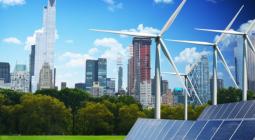La Financière de l’Echiquier: Did you say energy saving?

The climate emergency is no longer a matter of debate.The countdown is under way. The topic is no longer whether to act, but how. In this article.
The climate emergency is no longer a matter of debate. The countdown is under way. The topic is no longer whether to act, but how. Individuals, companies, governments…we’re all asking ourselves this question but there isn’t always an obvious answer… We have more options for action than ever, but which should we choose to maximise our positive impact?
Does new tech help?
In this technological age, the first option we reach for is technological innovation. Progress offers solutions to many environmental issues, opening up alternative ways of life; like replacing internal combustion engines with electric vehicles or coal-fired power plants with wind and solar farms. Reasonably comfortable options that do not require drastic transformation of our habits and consumption. However, many have pointed out that their real impact is less than clear. Critics cite hidden environmental costs and rebound effects[1]. An American think tank has shown that, across society as a whole, “for every two steps forward we take with below cost efficiency, rebound effects mean we take one or more steps backwards, sometimes enough to completely erode the initial gains made”[2]. To be viable, therefore, any alternative technology needs to scrutinise all its impacts as it advances.
The offset option
At the risk of making environmentally counter-productive choices, more and more people and companies are opting to offset their carbon footprint. One of the most popular is reforestation. Once you know that natural carbon sinks – oceans, vegetation, soil – absorb on average half the world’s annual CO2 emissions[3], this looks like a good choice. However, despite what you may hear from some oil companies and airlines, it takes more than tree-planting to become carbon neutral, and even more to counteract polluting activities. Any offsetting strategy must be backed by measures to significantly cut environmental impacts. Also, reforestation is only effective in capturing CO2 if a number of highly specific conditions are met, which they rarely are. The forest must be responsibly managed, so as to maintain or restore biodiversity and once trees mature, the wood must be used to make long-lasting goods. If left to rot, they will gradually release back into the atmosphere all the carbon locked up during their lifetime.
First solution: use less [save energy]
Given these ambiguous messages, there seems to be one solution that everyone can agree on: energy saving. This is at the heart of the IPCC’s scenario for keeping global warning to 2°C. The good news is that the potential impacts are huge, and we, from individuals to companies and states, can all do something. Individuals who want to cut their waste are, for instance, buying more and more bulk products, a market that has grown by 41% in 2019 in France and is set to hit €3.2 billion by 2022[4]. Companies are also active. They have a key role to play, whether by optimising production processes or through the products and services they offer. The Elis laundry company has taken this on board and has been striving to reduce its carbon footprint for several years now. They can now offer their clients a 10-fold reduction in their environmental impact if they have their workwear laundered collectively rather than doing it themselves.
At La Financière de l’Echiquier, the companies we choose understand that innovating, offsetting and, above all, saving energy are all links in a chain of solutions that can significantly improve their environmental impact.
[1] Rebound effect: the effect whereby any technological improvement to a good tends to increase energy consumption.
[2] Breakthrough Institute report
[3] Audrey GARRIC, Le Monde, 2019
[4] Vrac network
25 March 2020
Climate Action




